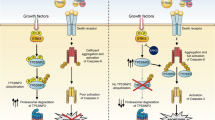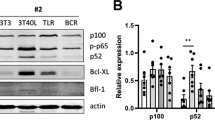Abstract
The standard treatments for chronic lymphocytic leukemia (CLL) include the alkylating agent chlorambucil (CLB) and the nucleoside analog fludarabine (F-ara-AMP, Flu). Tumor necrosis factor-related apoptosis-inducing ligand (TRAIL) is a death receptor ligand that induces apoptosis preferentially in tumors. However, CLL cells seem to be resistant to TRAIL-induced apoptosis. The TRAIL apoptotic signaling pathway has also been implicated in genotoxin-induced apoptosis through upregulation of TRAIL death receptors DR4 and DR5. In the present study, we demonstrate that the treatment of primary CLL cells with CLB or Flu increases the mRNA, protein and cell surface expression levels of DR4 and DR5 in a dose-dependent manner. In contrast to CLL cells, drug treatment fails to increase significantly the expression of DR4 or DR5 in normal lymphocytes. CLL cells are, however, resistant to TRAIL-induced apoptosis compared to B-cell lines. In contrast, combinational treatment using CLB or Flu with TRAIL (100 ng/ml) gave a synergistic apoptotic response. Furthermore, TRAIL is readily detectable on the cell surface of CLL cells, but TRAIL expression fails to increase following drug treatment. Preventing TRAIL from interacting with DR4 and DR5 decreases CLB-induced apoptosis in CLL cells. A similar, but less marked effect is observed with Flu. These findings indicate the involvement of the TRAIL apoptotic pathway in the mechanism of action of chemotherapy, and this mechanism could be utilized to sensitize CLL cells to TRAIL-induced apoptosis.
This is a preview of subscription content, access via your institution
Access options
Subscribe to this journal
Receive 50 print issues and online access
$259.00 per year
only $5.18 per issue
Buy this article
- Purchase on Springer Link
- Instant access to full article PDF
Prices may be subject to local taxes which are calculated during checkout







Similar content being viewed by others
References
Altucci L, Rossin A, Raffelsberger W, Reitmair A, Chomienne C and Gronemeyer H . (2001). Nat. Med., 7, 680–686.
Ashkenazi A and Dixit VM . (1999). Curr. Opin. Cell Biol., 11, 255–260.
Ashkenazi A, Pai RC, Fong S, Leung S, Lawrence DA, Marsters SA, Blackie C, Chang L, McMurtrey AE, Hebert A, DeForge L, Koumenis IL, Lewis D, Harris L, Bussiere J, Koeppen H, Shahrokh Z and Schwall RH . (1999). J. Clin. Invest., 104, 155–162.
Begleiter A, Mowat M, Israels LG and Johnston JB . (1996). Leuk. Lymphoma, 23, 187–201.
Begleiter A, Verburg L, Ashique A, Lee K, Israels LG, Mowat MR and Johnston JB . (1995). Leukemia, 9, 1875–1881.
Bodmer JL, Holler N, Reynard S, Vinciguerra P, Schneider P, Juo P, Blenis J and Tschopp J . (2000). Nat. Cell Biol., 2, 241–243.
Delmer A, Ajchenbaum-Cymbalista F, Tang R, Ramond S, Faussat AM, Marie JP and Zittoun R . (1995). Blood, 85, 2870–2876.
Di Pietro R, Secchiero P, Rana R, Gibellini D, Visani G, Bemis K, Zamai L, Miscia S and Zauli G . (2001). Blood, 97, 2596–2603.
Dighiero G and Binet JL . (2000). N. Engl. J. Med., 343, 1799–1801.
Dohner H, Stilgenbauer S, Benner A, Leupolt E, Krober A, Bullinger L, Dohner K, Bentz M and Lichter P . (2000). N. Engl. J. Med., 343, 1910–1916.
Friesen C, Fulda S and Debatin KM . (1999). Leukemia, 13, 1854–1858.
Fulda S, Strauss G, Meyer E and Debatin KM . (2000). Blood, 95, 301–308.
Genini D, Adachi S, Chao Q, Rose DW, Carrera CJ, Cottam HB, Carson DA and Leoni LM . (2000a). Blood, 96, 3537–3543.
Genini D, Budihardjo I, Plunkett W, Wang X, Carrera CJ, Cottam HB, Carson DA and Leoni LM . (2000b). J. Biol. Chem., 275, 29–34.
Gibson EM, Henson ES, Haney N, Villanueva J and Gibson SB . (2002). Cancer Res., 62, 488–496.
Gibson SB, Oyer R, Spalding AC, Anderson SM and Johnson GL . (2000). Mol. Cell. Biol., 20, 205–212.
Gottardi D, Alfarano A, De Leo AM, Stacchini A, Aragno M, Rigo A, Veneri D, Zanotti R, Pizzolo G and Caligaris-Cappio F . (1996). Br. J. Haematol., 94, 612–618.
Guan B, Yue P, Lotan R and Sun SY . (2002). Oncogene, 21, 3121–3129.
Irmler M, Thome M, Hahne M, Schneider P, Hofmann K, Steiner V, Bodmer JL, Schroter M, Burns K, Mattmann C, Rimoldi D, French LE and Tschopp J . (1997). Nature, 388, 190–195.
Johnston JB . (1999). Wintrobe's Clinical Hematology. Lee GR, Lukens J, Parakevas F, Green GR and Rodgers GM (eds). Williams & Wilkins: Baltimore, MD, pp. 2405–2427.
Johnston JB, Daeninck P, Verburg L, Lee K, Williams G, Israels LG, Mowat MR and Begleiter A . (1997). Leuk. Lymphoma, 26, 435–449.
Jones DT, Ganeshaguru K, Virchis AE, Folarin NI, Lowdell MW, Mehta AB, Prentice HG, Hoffbrand AV and Wickremasinghe RG . (2001). Blood, 98, 2800–2807.
Kim EJ, Suliman A, Lam A and Srivastava RK . (2001). Int. J. Oncol., 18, 187–194.
Kim Y, Suh N, Sporn M and Reed JC . (2002). J. Biol. Chem., 277, 22320–22329.
Kolbus A, Herr I, Schreiber M, Debatin KM, Wagner EF and Angel P . (2000). Mol. Cell. Biol., 20, 575–582.
Lens D, Dyer MJ, Garcia-Marco JM, De Schouwer PJ, Hamoudi RA, Jones D, Farahat N, Matutes E and Catovsky D . (1997). Br. J. Haematol., 99, 848–857.
Levesque MC, O'Loughlin CW and Weinberg JB . (2001). Leukemia, 15, 1305–1307.
Lincz LF, Yeh TX and Spencer A . (2001). Leukemia, 15, 1650–1657.
MacFarlane M, Harper N, Snowden RT, Dyer MJ, Barnett GA, Pringle JH and Cohen GM . (2002). Oncogene, 21, 6809–6818.
Menzel T, Rahman Z, Calleja E, White K, Wilson EL, Wieder R and Gabrilove J . (1996). Blood, 87, 1056–1063.
Mitsiades CS, Treon SP, Mitsiades N, Shima Y, Richardson P, Schlossman R, Hideshima T and Anderson KC . (2001). Blood, 98, 795–804.
Mitsiades N, Mitsiades CS, Poulaki V, Anderson KC and Treon SP . (2002). Blood, 99, 2162–2171.
Olsson A, Diaz T, Aguilar-Santelises M, Osterborg A, Celsing F, Jondal M and Osorio LM . (2001). Leukemia, 15, 1868–1877.
Pepper C, Thomas A, Hoy T, Cotter F and Bentley P . (1999). Br. J. Haematol., 107, 611–615.
Plasilova M, Zivny J, Jelinek J, Neuwirtova R, Cermak J, Necas E, Andera L and Stopka T . (2002). Leukemia, 16, 67–73.
Rai KR, Peterson BL, Appelbaum FR, Kolitz J, Elias L, Shepherd L, Hines J, Threatte GA, Larson RA, Cheson BD and Schiffer CA . (2000). N. Engl. J. Med., 343, 1750–1757.
Ravi R and Bedi A . (2002). Cancer Res., 62, 1583–1587.
Ravi R, Bedi GC, Engstrom LW, Zeng Q, Mookerjee B, Gelinas C, Fuchs EJ and Bedi A . (2001). Nat. Cell Biol., 3, 409–416.
Sankar M, Tanaka K, Kumaravel TS, Arif M, Shintani T, Yagi S, Kyo T, Dohy H and Kamada N . (1998). Leukemia, 12, 510–516.
Sayers TJ, Brooks AD, Koh CY, Ma W, Seki N, Raziuddin A, Blazar BR, Zhang X, Elliott PJ and Murphy WJ . (2003). Blood, 13, 13.
Schuler M and Green DR . (2001). Biochem. Soc. Trans., 29, 684–688.
Solary E, Droin N, Bettaieb A, Corcos L, Dimanche-Boitrel MT and Garrido C . (2000). Leukemia, 14, 1833–1849.
Takimoto R and El-Deiry WS . (2000). Oncogene, 19, 1735–1743.
Vrhovac R, Delmer A, Tang R, Marie JP, Zittoun R and Ajchenbaum-Cymbalista F . (1998). Blood, 91, 4694–4700.
Walczak H, Miller RE, Ariail K, Gliniak B, Griffith TS, Kubin M, Chin W, Jones J, Woodward A, Le T, Smith C, Smolak P, Goodwin RG, Rauch CT, Schuh JC and Lynch DH . (1999). Nat. Med., 5, 157–163.
Wen J, Ramadevi N, Nguyen D, Perkins C, Worthington E and Bhalla K . (2000). Blood, 96, 3900–3906.
Werner AB, de Vries E, Tait SW, Bontjer I and Borst J . (2002). J. Biol. Chem., 277, 40760–40767.
Wu GS, Kim K and el-Deiry WS . (2000). Adv. Exp. Med. Biol., 465, 143–151.
Zhao H, Dugas N, Mathiot C, Delmer A, Dugas B, Sigaux F and Kolb JP . (1998). Blood, 92, 1031–1043.
Acknowledgements
We thank the Genomic Centre for Cancer Research and Diagnostics for their technical support of this project. The research was supported by a translational research grant from the Leukemia and Lymphoma Society and a grant from Berlex Canada Inc. In addition, a Shaw Communication Fellowship from the Lymphoma Foundation of Canada supported AK's salary. Finally, we also thank the CancerCare Manitoba Foundation for their continuing support of research into chronic lymphocytic leukemia.
Author information
Authors and Affiliations
Corresponding author
Rights and permissions
About this article
Cite this article
Johnston, J., Kabore, A., Strutinsky, J. et al. Role of the TRAIL/APO2-L death receptors in chlorambucil- and fludarabine-induced apoptosis in chronic lymphocytic leukemia. Oncogene 22, 8356–8369 (2003). https://doi.org/10.1038/sj.onc.1207004
Received:
Revised:
Accepted:
Published:
Issue Date:
DOI: https://doi.org/10.1038/sj.onc.1207004
Keywords
This article is cited by
-
del(8p) and TNFRSF10B loss are associated with a poor prognosis and resistance to fludarabine in chronic lymphocytic leukemia
Leukemia (2023)
-
The novel thymidylate synthase inhibitor trifluorothymidine (TFT) and TRAIL synergistically eradicate non-small cell lung cancer cells
Cancer Chemotherapy and Pharmacology (2014)
-
Valproic acid enhances fludarabine-induced apoptosis mediated by ROS and involving decreased AKT and ATM activation in B-cell-lymphoid neoplastic cells
Apoptosis (2014)
-
Synergistic apoptotic response between valproic acid and fludarabine in chronic lymphocytic leukaemia (CLL) cells involves the lysosomal protease cathepsin B
Blood Cancer Journal (2013)
-
Imatinib enhances human melanoma cell susceptibility to TRAIL-induced cell death: relationship to Bcl-2 family and caspase activation
Oncogene (2006)



